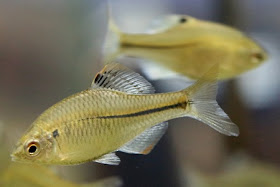I visited Sagamigawa Fureai Science Museum to see biological impacts of Fukushima No.1 nuclear power plant accident. Though I have visited various places in Japan to see the health consequences of the accident, I have never found any effect against creatures in Japan.
The museum features various exhibits, including a 40-meter-long aquarium that shows what the Sagami River is like both near the river source and near the river mouth and an exhibit showcasing the Tokyo bitterling, which has been declared a national treasure by the Japanese government and has been put on the national endangered wild plants and animals list.
Generally speaking, water creature's growth is so fast than human beings that they are more sensitive to radioactive materials of the environment than us. So I visited Sagamigawa Fureai Science Museum to see effects of the accident against creatures which are grown up by Japanese food and water. Fortunately, I could see them grown up safely and I couldn't find any impact of the accident. It seems that there is no problem for childbirth and child-rearing in Kanagawa Japan.
Posted by Yoshitaka Kiriake from Japan on September 2, 2014.
神奈川県の「相模川ふれあい科学館 アクアリウムさがみはら」では、相模川上流から河口までの生物を中心に約100種、4,000点以上の生物を展示している。特に淡水魚の展示が充実しており絶滅危惧種「タナゴ」のコレクションは秀逸だ。ニジマスのアルビノも見ることが出来た。
Rainbow trout (albino)
ニジマス (アルビノ)
Rainbow trout
ニジマス
Sagamigawa Fureai Science Museum
Google map
This museum exhibits many species of Japanese fresh water fish.
Tanakia limbata
アブラボテ
Acheilognathus tabira erythropterus
アカヒレタビラ
Acheilognathus tabira tabira
シロヒレタビラ
Tanakia lanceolata
ヤリタナゴ
Acheilognathus melanogaster
タナゴ
Rhodeus ocellatus kurumeus
ニッポンバラタナゴ
Rhodeus smithii smithii
カゼトゲタナゴ
Acheilognathus macropterus
オオタナゴ
Acheilognathus cyanostigma
イチモンジタナゴ
Acheilognathus typus
ゼニタナゴ
Masu trout
ヤマメ
Oikawa minnow
オイカワ
Amur Minnow
アブラハヤ
Ayu
アユ
Japanese crucian carp
ゲンゴロウブナ
Three-lips
ハス
White spotted char
イワナ
Japanese dace
ウグイ
Biwa oily gudgeon
Sarcocheilichthys variegatus microoculus
ビワヒガイ
We can see marine creatures of Sagami Bay too.
Japanese shillago
シロギス
Rabbitfish
Siganus fuscescens
アイゴ
Japanese common toad
Bufo japonicus formosus
アズマヒキガエル
Water stick insect
Ranatra chinensis
ミズカマキリ
Giant water bug
Lethocerus deyrollei
タガメ
Silkworms
カイコ
Discus
ディスカス
Japanese foods are good and safe.
Because of stricter food safety law by Japanese government, we have no worry about foods.
Misoshiru ; Miso soup with clam
Ekiben ; box lunch sold on a train or at a station
Shumai ; steamed meat dumpling
Suika ; Watermelon
Chocolate cake
Chocolate parfait
About 3 years have passed since Fukushima Daiichi nuclear power plant accident. I have visited various places of Japan to see the health consequence of the accident.
Fortunately I have never found any impacts by the accident among Japanese creatures. As far as I know, nobody has health problem which is caused by the accident in Japan.Our Prime Minister Abe assures that "The situation is under control and there will never be health problems." He also said that "Tokyo is 250 kilometers away from Fukushima, and the kind of danger that you imagine does not exist in Tokyo. Tokyo is a very safe city."
Kanagawa prefecture is very far away from Fukushima as same as Tokyo and people in Kanagawa have no concern about the nuclear power plant accident. People in Kanagawa prefecture have already forgotten the accident, because it is very far away from Fukushima and radioactive materials cannot reach there.
We know there is no problem for child birth and child rearing in Kanagawa. So people in Kanagawa are living without any concern about the accident.
I continue to visit various places in Japan to see the effects of the accident, because I can meet various creatures which are more sensitive to radioactive materials from the environment. It is important to see their health for our safety.
公衆衛生ネットワーク
Public Health Network in Japan






































0 件のコメント:
コメントを投稿